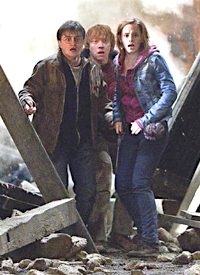
Harry Potter and the Deathly Hallows: Part 2 begins in medias res. After the Dark Lord (Ralph Fiennes) has stolen the Elder Wand from Albus Dumbledore’s (Michael Gambon) grave, he and his army of villains begin their march towards Hogwarts to launch what will be a battle of good versus evil.
Meanwhile, Harry (Daniel Radcliffe) and his two best friends, Ron (Rupert Grint) and Hermione (Emma Watson), continue to seek out the remaining Horcruxes that are the key to Voldemort’s mortality. The quest is a dangerous and difficult one, as the trio finds themselves in the gaping heart of Gringotts , Bellatrix Lestrange’s dragon-guarded vault, and a room full of forgotten treasures that sits below Hogwart’s itself.
Just when Harry and his friends believe they discovered the secret to Voldemort’s undoing, Harry uncovers a shocking secret, that there is one final step to the Dark Lord’s destruction, and it may be Harry’s undoing as well.
Harry Potter and the Deathly Hallows: Part 2 proves to be a dark but fulfilling close to the iconic series. Ten years ago, the Harry Potter movies launched what appeared at first to be an uncertain journey, but almost immediately found a committed following of fans, both young and old alike.
The first film, which opened in 2001, featured 11-year old orphan Harry Potter who lived with his unloving relatives in a tiny room no bigger than a closet. Harry’s introduction to the magical world of Hogwarts was tentative and awkward, but made easier by the friendships he developed along the way. Before long, Harry found a family and home in Hogwarts that grew in each passing book/film.
A decade later, Harry and his friends have not only grown into powerful, mature wizards, but they have found their strength and the courage to seek out the Dark Lord.
It’s amazing to note the progress that these three actors have made from their debut in the first film to the final film. While they were endearing from the start, it took some time for them to find their voices in their roles. Emma Watson was the most assured from the start, but by the final film, all three characters have not only advanced into loveable heroes, but their acting skills have been fine-tuned. It’s hard to imagine anyone else in the roles of Harry, Ron, and Hermione. Fortunately, we don’t have to.
Likewise, not only have the actors grown, both physically as well as in their acting skills, but the storyline has advanced to include the passionate relationships between the characters, most notably, Ron and Hermione. Those who have watched these two grow in love on screen will be delighted at the moment when the two finally exchange a passionate kiss that has taken years to develop.
The primary theme, and perhaps the most positive element, of Harry Potter and the Deathly Hallows: Part II, is the overwhelming sacrifice featured throughout. The most obvious is that made by Harry Potter, who has sacrificed himself in virtually every single film, in order to ensure the safety of Hogwarts and of his friends. In this installment, however, Harry’s sacrifice is climatic, as he believes his own life to be an obstacle in the efforts to defeat Lord Voldemort, and is therefore willing to lose it.
Also in this final installment, a number of characters willingly place themselves in the line in defense of Harry, of Hogwarts, and of all that is good. It certainly is not a simple decision for many of the characters to do so, as Lord Voldemort’s whisper is heard throughout the film, tempting others to stray from Harry and side with the Dark Lord. If not, they face dire consequences, and still, they stay, even when they believe Harry to be dead.
Another positive element in the film is the celebration of family. When Harry prepares to lose his life to defeat evil, he tells his Golden Snitch, “I am ready to die,” which opens the snitch and reveals the Resurrection Stone inside. Immediately, Harry’s parents as well as other loved ones he has lost appear to him and encourage him to carry out his sacrifice for the good of the world.
Likewise, the film’s conclusion reveals the characters we’ve come to love, with families of their own and children whom they are sending off to Hogwarts in the same fashion with which they were once sent. It highlights the family and the strength of childhood love that grows into something real. Likewise, it is a bittersweet and warm conclusion to the film series.
While Christian parents have articulated concerns with the use of magic in the film, this final installment seems to touch on Biblical elements, most notably the subject of death and afterlife, and the notion of salvation.
The film’s use of salvation is not entirely Biblical, as the characters are not saved through a Savior but through good deeds and through the decision to lead a good path rather than an evil one.
But the film has a clear message: those who choose to be good are rewarded while those who opt to be evil are offered no afterlife. And that afterlife permits families to be reunited.
The film steers clear of reference to God, or the notion of judgment and forgiveness. However, an argument can be made that Harry Potter (as was Aslan, the “Great Lion,” in C.S. Lewis’s The Chronicles of Narnia) is a Christ-like figure, as his sacrifice is absolutely necessary for the salvation of his world.
The scene wherein Harry heads off to the forest to meet Voldemort, and his fate, has parallels to Christ’s moment in the Garden of Gethsemane, when he struggled with a range of emotions. Though Potter has been encouraged by his deceased loved ones to fulfill the prophesy that has been outlined for him, it is clear that he is remains torn by his emotions up to the final moment when he and Voldemort meet.
And like Christ, Harry’s death is not permanent, as he is resurrected and returns to complete the fight against evil.
There is a great deal of violence in this film, which is to be expected as it focuses on a war between good and evil. Such is the horrifying reality of war. Though very little of it is graphic, there are a few moments that may make some uncomfortable. Many die in the process, including young would-be wizards, adding to the ominous nature of the film.
In all, Harry Potter and the Deathly Hallows: Part 2 proves to be a gratifying conclusion to the Harry Potter saga. Full of the same theatricality and cinematography that has characterized each film, and with goodness prevailing in the end, it proves to be an excellent close to a wonderful series.




